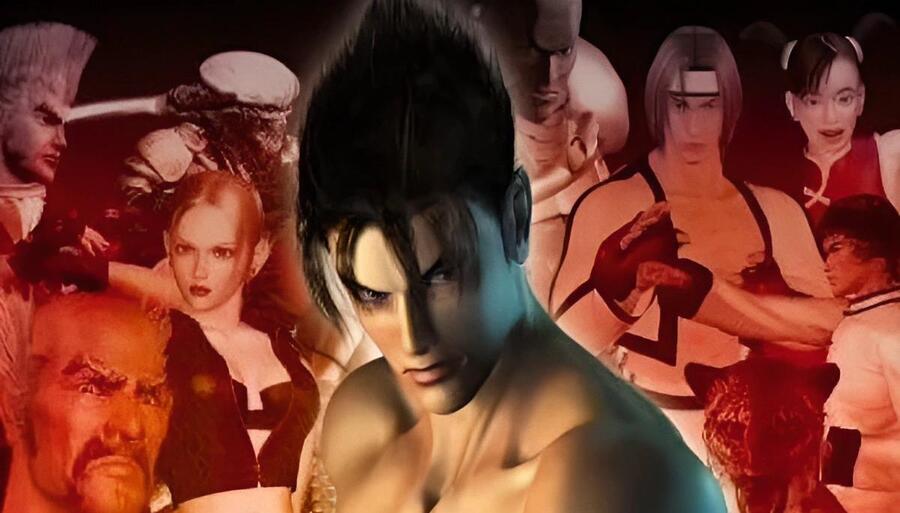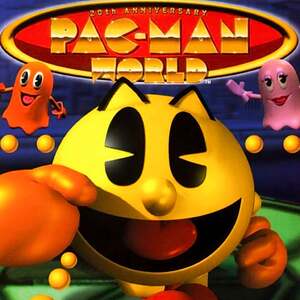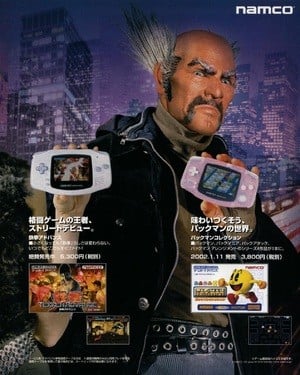
Tekken Advance is the one of the stranger entries in Namco's long-running fighting game series. Released for the Game Boy Advance in 2001, it is commonly mistaken for a straightforward port of Tekken 3, but is instead a non-canonical entry in the series that arguably shares a lot more in common with the PlayStation 2 title Tekken Tag Tournament, which was released one year prior.
The first ever Tekken to be launched for a handheld platform, it arrived at a time when Tekken was primarily associated with sophisticated arcade hardware and cutting edge Sony consoles, and, as a result, generated a lot of curiosity and attention from fans and gaming outlets, with many wondering how Namco and the game's developer Eighting were going to be able to squeeze the visually impressive 3D fighter onto a console primarily known for its sprite-based 2D games.
Nevertheless, squeeze they did, ultimately releasing what can best be described as a stripped down version of the popular fighter that, while not exactly living up to its arcade, PS1, & PS2 counterparts, managed to look and feel just close enough to the real thing, while pushing the GBA hardware to its absolute limits.
In the past, I've always been interested to learn more about this unusual entry in the series and the circumstances surrounding its development, having been first introduced to it through coverage in UK-based game magazines of the time, such as NGC and Gamesmaster. However, its only recently, as I've come to unearth my old copy of the game over the last couple of months, that I've made the effort to try and reach out to some of the individuals responsible for its creation, which led me to get in touch with the former Namco Hometek employee Yasuhiro Noguchi.

Noguchi was credited on the title as a project director, having previously joined Namco Hometek, the North American subsidiary of the famous Japanese developer and publisher, in 1997, from Sega of America.
As he told me, he originally got the job thanks to his old friend Jesse Taylor, another Sega of America alum, who, at the time, was the director of R&D at Hometek and was then going through the challenging process of restructuring the studio, in order to reboot the original Pac Man World, which was considered to be a "make-or-break" title for the company.
"Yoshinori Homma was the president of Namco Hometek in San Jose," Noguchi told me. "He took a big chance on Pac-Man World 1 development at Namco Hometek. That project wasn’t really approved by Namco Japan, as Pac-Man wasn’t seen as a viable IP in Japan at the time. Mr. Homma knew that he had to reset the project and bring new blood onboard at Namco Hometek to finish and release that game. And it paid off handsomely because it was successful and enabled Namco Hometek to develop its own original games."
According to Noguchi, after arriving at Namco Hometek, he would be assigned the role of a localization producer, going on to work on a range of Namco titles including the 2.5D platformer Klonoa: Door to Phantomile and the PlayStation port of Tekken 3. In the case of the latter, he even got to travel to Namco’s R&D office in Yokohama, Japan and worked directly with the Tekken group, establishing a friendship with much of the team. It's arguably because of this connection that, when the president of Namco Hometek suggested several years later to kickstart the development of a new Tekken game for the Game Boy Advance, he selected Noguchi to head up its development, believing him to be the perfect candidate to help coordinate its development across continents.

"Homma wanted another title to sell on a Nintendo platform after we successfully launched Namco Museum 64 in the US," said Noguchi. "Back in the late 90’s, Namco Hometek was trying to release games on the Nintendo platform to expand its business in the US. Our arcade hardware for Tekken at the time was based on the PlayStation chipset, so we couldn’t release Tekken 3 on the N64 and it also didn't make any business sense for us. So we developed and published something dedicated to the Game Boy Advance instead with Tekken Advance."
Tekken Advance was a collaboration between Namco Hometek and Namco Japan, as well as the developer Eighting, with the latter having impressed Namco Japan thanks to its earlier work on the arcade fighting game series Bloody Roar and a bunch of Namco-published lightgun games (including Ghoul Panic and a trilogy of games based on the hitman-themed manga series Golgo-13).
As Noguchi recalls, due to Namco's existing relationship with Nintendo (a relationship which dated all the way back to the Nintendo Famicom days), it was relatively easy for the Namco R&D leadership in Japan, led by Shigeru Yokoyama, to pull some strings to send Game Boy Advance devkits over to Eighting, despite the handheld being brand new when development on the project began.
What was slightly harder, though, was figuring out how they were going to adapt the 3D fighter's graphics into something that would fit on the less powerful machine, with the approach they eventually landed on being to use pre-rendered sprites, based on the 3D models included in the PS2 version of Tekken Tag Tournament. This is an approach that saw Namco Japan break down each of the character's moves into specific frames, which were then reproduced as sprites and reassembled in the final game by Eighting.
In total, Tekken Advance included 10 playable characters, with nine of these available to you when you first start the game: Forest Law, Gun Jack, Nina Williams, Yoshimitsu, Paul Phoenix, King, Jin Kazama, Hwoarang, Ling Xiaoyu. This is essentially the starting line-up of Tekken 3, with the exception of Gun Jack (who had been substituted in for the missing characters Lei Wulong and Eddy Gordo).
Explaining the decision to leave Lei and Eddy out of the game, Noguchi told me, "Eddy Gordo’s wild capoeira moves were considered way too memory hungry for the Game Boy Advance, and we figured Lei Wulong wouldn’t fit on the cartridge during the preproduction stage."
The final unlockable character in the game, meanwhile, was the end boss of the arcade mode, Heihachi, who could only be unlocked after completing the game with each of the existing roster members. I asked Noguchi if any other unlockable characters were ever planned, such as Bryan, Julia, or Kuma — all of whom appear in both Tekken 3 and Tekken Tag Tournament — but sadly it seems that no such plans ever existed, with the developers pretty much maxing out what they were able to fit on the cartridge.
"I don’t really remember cutting any other characters from the game during the development, as the Eighting team did such an amazing job squeezing in all the characters we had in the game. I don’t recall how big the cart was, but I remember we really maxed out the cartridge with game data.
"One thing that we were particularly concerned about was the amount of RAM each character took when loaded up for a fight (this is applicable for any console, by the way). During development, I recall we had some crash bugs where King’s moves occupied too much RAM, and we had to ensure that he and the other characters would work without any issues."
Notably, memory allocation wasn't the only thing the developers had to be careful about either, with another key problem being how to recapture the same classic Tekken experience on a handheld with a smaller amount of inputs available.
Up until Tekken Advance, all of the previous Tekken titles had all used a similar four-button control scheme, that featured two buttons for kicking and two buttons for punching. However, this wasn't something that was easy to replicate 1:1 on the GBA due to the system only really having an A + B button available to use.
As a compromise, the team, therefore, decided to cut down the available moveset for each character, assigning the B button as the primary means of punching, with A being reserved for kicks, and the right shoulder button being used for "throws". Speaking of throws, most of the character's standard throws were ultimately replaced in the game with a short series of combos, with King and Nina's chain throws having to be reproduced via brief non-playable cutscenes.
The game director in Namco Japan, Mitsumasa Fujita and the game director at Eighting, Shoji Fukuda did an amazing job with paring down the gameplay while maintaining the essence of Tekken.
"We really had to shorten the move list for Tekken Advance, and the game director in Namco Japan, Mitsumasa Fujita and the game director at Eighting, Shoji Fukuda did an amazing job with paring down the gameplay while maintaining the essence of Tekken," said Noguchi.
Despite these changes having to be made, a lot of features from previous Tekken games did end up being retained, with players still being able to pull off the series's famous 10-hit combos, and being able to sidestep around their opponent despite the "headaches" it apparently caused the team. In addition to this, there were also some new featured that were introduced, including a bunch of additional stuns that gave players more openings to punish their opponent in battle.
According to Noguchi, with the team being unable to fit more characters and moves from Tekken Tag Tournament and Tekken 3 into the game, Namco and Eighting instead made the decision to include a wide range of playable modes available, with the hope that this would make the package more appealing to returning players. This included the main Arcade mode, as well as a VS. mode, Time Attack mode, Survival mode, and a Practice mode.
Undoubtedly, the most interesting of all of these, though, was the addition of a 3 vs 3 tag mode, which is still the only instance of a 3 vs 3-style mode within the whole of the Tekken series (the two Tekken Tag Tournament titles only being limited to 2 vs 2 battles). This functions roughly the same as the 2 vs 2 battles in Tekken Tag Tournament, just with an additional character added to each team, with players being able to select a team of three fighters before being thrown into a random map against the computer or another player with the Game Boy Advance link cable.
Once the battle commences, you're initially put into what appears to be a standard 1 vs 1 fight, with the option to tap the left shoulder button on the Nintendo handheld at any time to switch out to a different character. The battle ends once one side manages to defeat one of the characters on the other team, which is a feature unique to the Tag Mode in the Tekken series and different to other fighting games, like the Capcom vs. series, where you need to clear the entire team, in order to claim the victory.
Tekken Advance launched in Japan on December 2001, with the North American and European versions releasing the year after, in 2002, in January and March respectively.
At the time of its US release, it received some fairly positive reviews from gaming outlets, with most of the critics at the time enjoying the novelty of playing Tekken game on a Nintendo handheld and praising the effort it must have took to get the game working, while simultaneously expressing some mild disappointment at the lack of unlockable characters and what they described as "cut corners".
IGN's Craig Harris, for instance, called it "an extremely pretty game and a relatively fun game", giving it an 8.5 out of 10, but went on to state elsewhere in his review for the website that he was "disappointed to find out that Tekken Advance doesn't have a whole lot of options" as "half the fun of the past console versions was unlocking all sorts of extras tucked away in the game".
Jeff Gerstmann, meanwhile, writing for Gamespot, also proved to be pretty enthusiastic about the portable version of Tekken, describing Tekken Advance in his review as "a solid fighting game" and awarding the game an 8 out of 10. Similar to Harris, though, he also had some minor criticisms, referring to the revised control scheme as "a little awkward at first", and describing the animation as "fairly choppy".
With the feedback to the game skewing positive, you may be wondering if there were ever any plans to bring other Namco fighting games, like Soul Blade or Soulcalibur, to the handheld to build on this success, but the answer to that seems to be a resounding no, with Noguchi telling us "We didn’t really consider additional fighting games on the GBA".
Instead, Tekken Advance was simply left as a curious one-and-done for the console, with fans having to wait another four or five years (depending on where they lived) before the next handheld entry, Tekken: Dark Resurrection, released on the PlayStation Portable in 2006.

